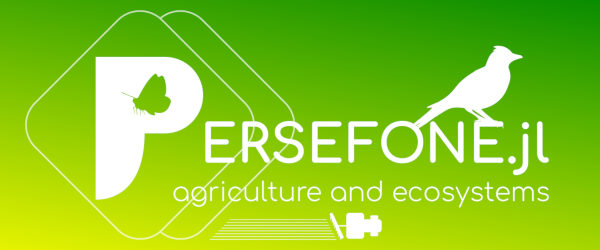# Persefone.jl

**A multidisciplinary mechanistic model of agricultural landscapes and ecosystems in Europe.**
## Description
[Persefone.jl](https://persefone-model.eu/) models agricultural practice and
how it impacts animal species at a landscape scale. It includes a farm submodel, a crop
growth submodel, and individual-based models of multiple indicator species. Its aim is to
investigate how changes in farm operations (e.g. through changes in the European Common
Agricultural Policy) influence biodiversity.
**The model is still in development. A first version will be available in spring 2025.**
## Usage
*For the full documentation, visit the [website](https://persefone-model.eu/documentation), or read the manual in the `docs` folder.
To use Persefone.jl with a graphical user interface, see [here](https://git.idiv.de/persefone/persefone-desktop).*
### Installation
Install the latest version of the [Julia](https://julialang.org/downloads/) programming
language (1.10+). The recommended editors are [VSCode](https://www.julia-vscode.org/) or
[Emacs](https://www.emacswiki.org/emacs/JuliaProgrammingLanguage). Clone this
repository, then install package dependencies by opening a Julia REPL in the Persefone
root folder and running `using Pkg; Pkg.activate("."); Pkg.instantiate()`.
Alternatively, if you only want to use the package from within Julia (see below),
you can install it directly in any Julia REPL:
```julia
using Pkg
Pkg.add(url="https://git.idiv.de/persefone/persefone-model.git")
using Persefone
```
### Running from the command line
This is the normal mode of operation. Simply execute `run.jl` in a terminal, typically like
so (in Linux):
```
> julia run.jl -c <config>
```
where `<config>` specifies the configuration file to use. The recommended workflow is
to copy `scr/parameters.toml` to a location of your choice and edit the copy to suit
your requirements. The adapted config file can then be passed to `run.jl`. (If no
configuration file is specified, Persefone will run with its default settings.)
The full list of commandline arguments is:
```
usage: run.jl [-c CONFIGFILE] [-s SEED] [-o OUTDIR] [-l LOGLEVEL]
[--version] [-h]
optional arguments:
-c, --configfile CONFIGFILE
name of the configuration file
-s, --seed SEED inital random seed (type: Int64)
-o, --outdir OUTDIR location of the output directory
-l, --loglevel LOGLEVEL
verbosity: "debug", "info", or "quiet"
--version show version information and exit
-h, --help show this help message and exit
```
To run the test suite, switch to the `test` directory and execute `runtests.jl`.
If you are on Linux or MacOS, you can also use `make`:
```
> make run # run a simulation with default values
> make test # run the test suite
> make profile # run and profile a default simulation
> make docs # build the documentation
> make release # create a release
```
### Running from within Julia
To use the model from within Julia (either inside an interactive REPL or if you want
to import it from your own software), do the following:
```julia
using Pkg
Pkg.activate(".") # assuming you're in the Persefone root folder
using Persefone
```
You can then access all Persefone functions, such as
[`simulate()`](https://persefone-model.eu/documentation/simulation.html#Persefone.simulate)
(which runs a complete simulation, as when calling `julia run.jl` from the commandline).
See [`src/Persefone.jl`](https://git.idiv.de/persefone/persefone-model/-/blob/master/src/Persefone.jl?ref_type=heads)
or the [documentation](https://persefone-model.eu/documentation/simulation.html) for a
list of exported functions.
---
© 2022-2025 the contributors (MIT license)